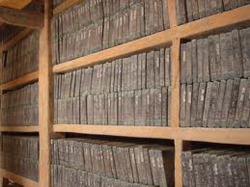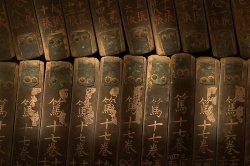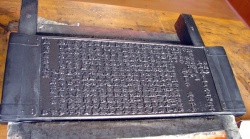Tripitaka
Tripiṭaka (Pali: Tipitaka) is a Sanskrit word meaning Three Baskets. It is the traditional term used by Buddhist traditions to describe their various canons of scriptures. The expression Three Baskets originally referred to three receptacles containing the scrolls on which the Buddhist scriptures were originally preserved. Hence, the Tripiṭaka traditionally contains three "baskets" of teachings: a Sūtra Piṭaka (Sanskrit; Pali: Sutta Pitaka), a Vinaya Piṭaka (Sanskrit & Pali) and an Abhidharma Piṭaka (Sanskrit; Pali: Abhidhamma Piṭaka).
The three categories
Tripitaka is the three main categories of texts that make up the Buddhist canon.
Sutras
See also: Mahayana sutras and Sutta Pitaka
These are mainly teachings and sermons of Buddha originally transcribed in Sanskrit or Pali. They may contain descriptions of Buddha and parables which may help lead to Enlightenment of the reader.
Abhidharma
See also: Abhidharma
Philosophical and psychological discourse and interpretation of Buddhist Doctrine.
Vinaya
See also: Vinaya
Rules and regulation of monastic Life that range from dress code and dietary rules to prohibition in personal conduct.
In Indian Buddhist schools
Each of the Early Buddhist Schools likely had their own recensions of the Tripiṭaka. According to some sources, there were some Indian schools of Buddhism that had five or seven piṭakas.
Mahāsāṃghika
The Mahāsāṃghika Vinaya was translated by Buddhabhadra and Faxian in 416 CE, and is preserved in Chinese translation (Taishō Tripiṭaka 1425).
The 6th century CE Indian Monk Paramārtha wrote that 200 years after the parinirvāṇa of The Buddha, much of the Mahāsāṃghika school moved north of Rājagṛha, and were divided over whether the Mahāyāna teachings should be incorporated formally into their Tripiṭaka. According to this account, they split into three groups based upon the relative manner and degree to which they accepted the authority of these Mahāyāna texts. Paramārtha states that the Gokulika sect did not accept the Mahāyāna sūtras as buddhavacana ("words of The Buddha"), while the Lokottaravāda sect and the Ekavyāvahārika sect did accept the Mahāyāna sūtras as buddhavacana. Also in the 6th century CE, Avalokitavrata writes of the Mahāsāṃghikas using a "Great Āgama Piṭaka," which is then associated with Mahāyāna sūtras such as the Prajñāparamitā and the Daśabhūmika Sūtra.
According to some sources, Abhidharma was not accepted as canonical by the Mahāsāṃghika school. The Theravādin Dīpavaṃsa, for example, records that the Mahāsāṃghikas had no Abhidharma. However, other sources indicate that there were such collections of Abhidharma, and the Chinese pilgrims Faxian and Xuanzang both mention Mahāsāṃghika Abhidharma. On the basis of textual evidence as well as inscriptions at Nāgārjunakoṇḍā, Joseph Walser concludes that at least some Mahāsāṃghika sects probably had an Abhidharma collection, and that it likely contained five or six Books.
Caitika
The Caitikas included a number of sub-sects including the Pūrvaśailas, Aparaśailas, Siddhārthikas, and Rājagirikas. In the 6th century CE, Avalokitavrata writes that Mahāyāna sūtras such as the Prajñāparamitā and others are chanted by the Aparaśailas and the Pūrvaśailas. Also in the 6th century CE, Bhāvaviveka speaks of the Siddhārthikas using a Vidyādhāra Piṭaka, and the Pūrvaśailas and Aparaśailas both using a Bodhisattva Piṭaka, implying collections of Mahāyāna texts within these Caitika schools.
Bahuśrutīya
The Bahuśrutīya school is said to have included a Bodhisattva Piṭaka in their canon. The Satyasiddhi Śāstra, also called the Tattvasiddhi Śāstra, is an extant Abhidharma from the Bahuśrutīya school. This Abhidharma was translated into Chinese in sixteen fascicles (Taishō Tripiṭaka 1646). Its authorship is attributed to Harivarman, a third-century Monk from central India. Paramārtha cites this Bahuśrutīya Abhidharma as containing a combination of Hīnayāna and Mahāyāna doctrines, and Joseph Walser agrees that this assessment is correct.
Prajñaptivāda
The Prajñaptivādins held that The Buddha's teachings in the various piṭakas were nominal (Skt. prajñapti), conventional (Skt. saṃvṛti), and causal (Skt. hetuphala). Therefore all teachings were viewed by the Prajñaptivādins as being of provisional importance, since they cannot contain the ultimate truth. It has been observed that this view of The Buddha's teachings is very close to the fully developed position of the Mahāyāna sūtras.
Sārvāstivāda
Scholars at present have "a nearly complete collection of sūtras from the Sarvāstivāda school" thanks to a recent discovery in Afghanistan of roughly two-thirds of Dīrgha Āgama in Sanskrit. The Madhyama Āgama (Taishō Tripiṭaka 26) was translated by Gautama Saṃghadeva, and is available in Chinese. The Saṃyukta Āgama (Taishō Tripiṭaka 99) was translated by Guṇabhadra, also available in Chinese translation. The Sarvāstivāda is therefore the only early school besides the Theravada for which we have a roughly complete Sūtra Piṭaka. The Sārvāstivāda Vinaya Piṭaka is also extant in Chinese translation, as are the seven Books of the Sarvāstivāda Abhidharma Piṭaka. There is also the encyclopedic Abhidharma Mahāvibhāṣa Śāstra (Taishō Tripiṭaka 1545), which was held as canonical by the Vaibhāṣika Sarvāstivādins of northwest India.
Mūlasārvāstivāda
Portions of the Mūlasārvāstivāda Tripiṭaka survive in Tibetan translation and Nepalese manuscripts. The relationship of the Mūlasārvāstivāda school to Sarvāstivāda school is indeterminate; their vinayas certainly differed but it is not clear that their Sūtra Piṭaka did. The Gilgit manuscripts may contain Āgamas from the Mūlasārvāstivāda school in Sanskrit. The Mūlasārvāstivāda Vinaya Piṭaka survives in Tibetan translation. The Gilgit manuscripts also contain Vinaya texts from the Mūlasārvāstivāda school in Sanskrit.
Dharmaguptaka
See also: Gandhāran Buddhist Texts
A complete version of the Dīrgha Āgama (Taishō Tripiṭaka 1) of the Dharmaguptaka school was translated into Chinese by Buddhayaśas and Zhu Fonian (竺佛念) in the Later Qin dynasty, dated to 413 CE. It contains 30 sūtras in contrast to the 34 suttas of the Theravadin Dīgha Nikāya. A.K. Warder also associates the extant Ekottara Āgama (Taishō Tripiṭaka 125) with the Dharmaguptaka school, due to the number of rules for monks and nuns, which corresponds to the Dharmaguptaka Vinaya. The Dharmaguptaka Vinaya is also extant in Chinese translation (Taishō Tripiṭaka 1428), and Buddhist monks and nuns in East Asia adhere to the Dharmaguptaka Vinaya.
The Dharmaguptaka Tripiṭaka is said to have contained a total of five piṭakas. These included a Bodhisattva Piṭaka and a Mantra Piṭaka (Ch. 咒藏), also sometimes called a Dhāraṇī Piṭaka. According to the 5th century Dharmaguptaka Monk Buddhayaśas, the translator of the Dharmaguptaka Vinaya into Chinese, the Dharmaguptaka school had assimilated the Mahāyāna Tripiṭaka (Ch. 大乘三藏).
Mahīśāsaka
The Mahīśāsaka Vinaya is preserved in Chinese translation (Taishō Tripiṭaka 1421), translated by Buddhajīva and Zhu Daosheng in 424 CE.
Kāśyapīya
Small portions of the Tipiṭaka of the Kāśyapīya school survive in Chinese translation. An incomplete Chinese translation of the Saṃyukta Āgama of the Kāśyapīya school by an unknown translator circa the Three Qin (三秦) period (352-431 CE) survives.
In the Theravada school
The complete Tripiṭaka set of the Theravāda school is written and preserved in Pali in the Pali Canon. Buddhists of the Theravāda school use the Pali variant Tipitaka to refer what is commonly known in English as the Pali Canon.
Use of the term in Indo-Tibetan and East Asian Mahāyāna
The term Tripiṭaka had tended to become synonymous with Buddhist scriptures, and thus continued to be used for the Chinese and Tibetan collections, although their general divisions do not match a strict division into three piṭakas. In the Chinese tradition, the texts are classified in a variety of ways, most of which have in fact four or even more piṭakas or other divisions.
The Chinese form of Tripiṭaka, "sānzàng" (三藏), was sometimes used as an honorary title for a Buddhist monk who has mastered the teachings of the Tripiṭaka. In Chinese culture this is notable in the case of the Tang Dynasty Monk Xuanzang, whose pilgrimage to India to study and bring Buddhist text back to China was portrayed in the novel Journey to the West as "Tang Sanzang" (Tang Dynasty Tripiṭaka Master). Due to the popularity of the novel, the term "sānzàng" is often erroneously understood as a name of the Monk Xuanzang. One such screen version of this is the popular 1979 Monkey (TV series).
The modern Indian scholar Rahul Sankrityayan is sometimes referred to as Tripitakacharya in reflection of his familiarity with the Tripiṭaka.



